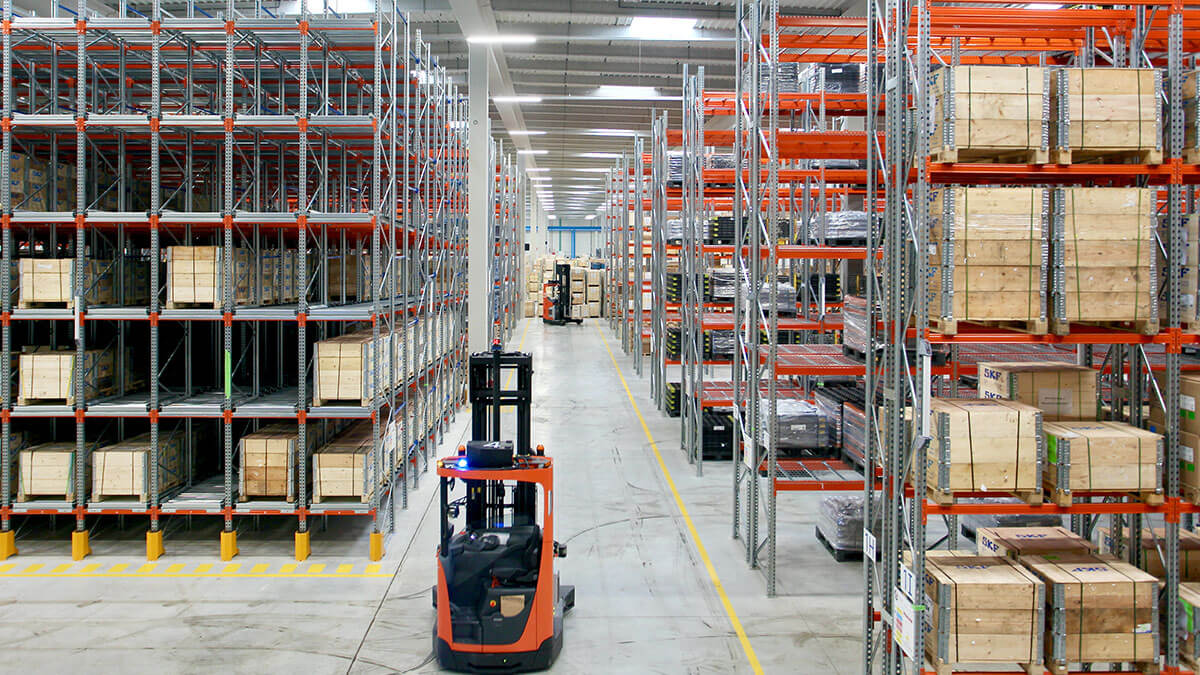As the demand for warehousing is ever-growing—especially today, with the boom in e-commerce, globalization, and just-in-time delivery models—it is important for businesses to create warehouse layouts aimed at maximum exploitation of available space, smoothing processes, and reduction of operational costs.
This blog aims to help people understand many aspects of warehouse layout design, including the types of layouts, major considerations, areas of primary setup, and so on.
What would be an excellent Warehouse layout design?
The impact of an efficient and effective warehouse design can be felt in many ways in enhancing productivity, safety, and operational efficiency.
Productivity and Safety in Warehouse
Easy Location of Stock: The items in an organized warehouse are stored in locations indicated; these locations are so well indicated that the warehouse staff can locate the products with ease. This maximizes the speed, reducing picking time to ensure timely order fulfillment and higher productivity.
Effective Movement: Planning out locations of items and the providing of distinct pathways allow for the elimination of obsolete travel within a warehouse. This kind of planning enables workers to be able to move around in some logical way, hence reducing idle time wasted when walking from storage areas to picking, then to packing, and finally to shipping.
Less Waiting Time: A facility perfectly laid out shall optimize the flow of the goods from receipt to shipment. This will help reduce waiting time at the different stages a supply chain process passes through, hence enabling quicker turnarounds of customers’ orders and improved service levels.
Improved Safety: Safety is the most important aspect of a warehouse operation. A good design must therefore incorporate safety features in the warehouse, such as proper marking of aisles, separate and distinctly marked pedestrian walkways that keep pedestrians out of the forklift traffic, and ergonomic workstations. This diminishes the occurrence of accidents and injuries at the workplace, hence creating a much safer atmosphere for warehouse personnel.
Equipment Longevity
Less Wear and Tear: There is less wear on machinery such as forklifts, pallet jacks, and conveyors because of the optimal workflows and spacing allowed between storage racks, workstations, and loading areas. This helped in reduced congestion and less frequent maneuvering of equipment.
Technology Integration: It is very important that the new warehouse design fully equipped with the latest technologies. Some examples being automated storage and retrieval systems, barcode scanners, and the most modern inventory management software. The technologies individually help in operations, providing greater accuracy in inventory and real-time analytics data for decision-making.
Increased Satisfaction of Employees: Other than operational efficiency, a good warehouse layout promotes employee satisfaction by decreasing physical stress, stress from disorderly workflows, and promoting safety at work.
Also learn about Data Centre Design: Guidelines and Best Practices
Types of Warehouse Layout Designs
The appropriate warehouse layout design needs to be selected based on the operational needs. Some common types, along with their descriptions, advantages, and disadvantages, are as follows communicator mentioned above
Linear or Straight Line Layout:

This is a simple, straight-line design whereby processes run linearly from receiving to shipping. Goods move along a single line, going through storage, picking, packing, and then shipping.
Pros:
- Easy to Implement: Simple to design, understand, and implement. It suits operations that do not need complex handling processes.
- Best for small operations; ideal for small warehouses with less inventory and fewer processes where simple movement is enough.
Cons:
- Limited Flexibility: The fixed linear path makes it quite difficult to adjust to changes in workflow or increases in volume.
- Potential Congestion: The single line flow, during times of peak activity, can lead to bottlenecks and congestion, reducing the speed of the entire process.
U-Shaped Layout

Receiving and shipping docks are paired at the open ends of the U, and storage and handling areas form the shape around them. Inbound and outbound processes can easily be separated and organized in this layout.
Benefits:
- Space Efficiency: It uses available floor space in the best manner.
- Separation of Processes: Inbound and outbound activities are clearly separated, thereby minimizing the risk of cross-contamination or mix-ups.
- Flexibility: Aisle picking can be adopted for both fast-moving and slow-moving products, hence providing enormous flexibility while tackling various ranges of inventory.
L-Shaped Layout

In this kind of layout, receiving and shipping docks are placed on adjacent sides of the warehouse; and the storage and handling areas turn in the shape of an L around those points. This kind of configuration is used especially for medium-sized operations.
Pros:
Facilitates smooth, efficient flows of goods between receiving, storage, and shipping activities. Separation of receiving and shipping functions is good, as it keeps the processes of receiving and shipping separate, thereby minimizing potential interference.
Cons:
Potential Congestion: Not appropriate for high-volume operations due to congestion created by the L-shaped path during busy periods.
I-Shaped Layout

I-shaped layout means that the path is straight, directly from receiving to shipping, with storage areas on either side of a pathway. That is applied in larger warehouses with a huge inventory volume.
Pros:
- Simplicity and Efficiency: Easy design, easier to manage, makes for very clear, simple workflow
- Clear Pathway: A distinct, unobstructed pathway from one end to another for goods.
Cons:
- Limited Flexibility: Less flexible to change or expansion in the operation.
- Bottlenecking: Can create bottlenecks, particularly if the central path becomes congested with workers and equipment.
Essential Areas in Setting up a Warehouse
A good warehouse should include the following areas as key components to ensure the effective and orderly running of operations, productivity, and safety. This includes storage and inventory areas.
Storage and Inventory Areas
The storage and inventory areas should be well-structured within the warehouses. These structures provide accommodation for many types of inventory and are very important in ensuring easy access to the inventory items. Some other key features also include different shelving and racking systems, like pallet racks, cantilever racks, and bin shelving, depending on the nature and size of the inventory. Labeling and signage in these areas allow for easy and quick identification of items, thus catching errors before they happen and reducing search time. In addition to this, climate-controlled areas are used for storing sensitive items at the right conditions to maintain the quality and safety of a product.
Inbound Receiving Dock
The receiving dock is a section in the warehouse where products go through receiving, inspection, and processing before being stored. Some of its key features are the main equipment that includes the docs, dock levelers, and bumpers, which accelerate and complement the offloading of products from incoming vehicles. Inspection stations are strategically located to ensure that the incoming goods undergo product quality, quantity, and accuracy checking against purchasing orders. This also identifies temporary holding zones within this area, where goods can be accommodated temporarily before being processed and sent to appropriate storage locations to facilitate smooth workflow and inventory management.
Picking and Packing Areas
These are warehouse picking and packing areas, very important locations meant for retrieving the items from storage locations and making them ready for shipment to customers. They have ergonomically designed pick stations where items are efficiently gathered by warehouse staff from their corresponding storage areas. Next to these are the respective packing stations, with essential packing materials, a weight scale to weigh all the items, and labeling equipment to appropriate items for packaging. Not to forget the order consolidation areas, that are tactically located for the final verification and consolidation of picked items before packing to ensure accuracy in order fulfillment processes. These consolidated areas increase efficiency, maximize workflow, and help in the quick processing of orders to the satisfaction of customers.
Outbound Shipping Dock
The outbound shipping dock is the last point or stage in a warehouse that deals with the preparation of packed orders for shipment. It is usually a critical zone where orders are sorted and staged for shipment, sometimes by carrier or by route to optimize loading. Some of the main features include the staging areas, where items ordered are packed and then wait for loading into the delivery vehicles, thus ensuring outbound operations are organized and orderly. Conveyors, fork-lifts, and pallet jacks in a warehouse are some of the loading equipment that are used to provide safety and efficiency during loading. A dock scheduling system is also provided for managing and scheduling appointments to the dock. This ensures that loading is coordinated and executed in a timely manner to achieve delivery deadlines and meet customer expectations.
Employee Spaces
Employee spaces are assigned for warehouse employees to take breaks, conduct meetings, or even perform administrative duties in a setting that will allow them to work effectively and efficiently. These are some of the areas that contain facilities, such as comfortable break rooms, complete with seats, microwaves, refrigerators, coffee makers, and a place for employees to rest during working hours. It provides for meeting rooms for teams to meet, train, or hold briefings for proper communication and planning by warehouse personnel. Administrative offices are also equipped with the necessary supplies, computers, and documentation storage to accomplish managerial tasks and support the smooth running of administrative operations in a warehouse environment. If well integrated, these spaces have much to contribute to workers’ well-being, productivity, and organizational efficiency.
Organization within a properly set-up warehouse defines clear areas for storage, receiving, picking, packing, shipping, and employee needs. Ensuring that all these identified areas are well designed and fitted with adequate equipment ensures the smoothing of warehouse processes, thereby increasing productivity and providing a safer and more efficient environment for the staff on duty.
Explore more about Workplace Interior : A Guide to Contemporary Office Design
Equipment and Workspace Planning in Warehouse
If your previous two steps are inconspicuous in planning considerations, one might say that this is where the rubber hits the road in terms of productive–and safe–warehouse operation. Here is further elucidation of how effective planning for the concerned equipment and surrounding workspaces can be carried out.
Plan for Equipment and Surrounding Workspace in a Warehouse
- Identify the Key Units: The place to start in all this is to identify the key units of equipment necessary for your warehouse operation. This could be a combination of forklifts, pallet jacks, conveyors, packaging machines, and special machinery that is available in any place for performing special tasks.
- Provide adequate space: Properly allocate space to every piece of equipment such that the provided space allows it to operate well without creating a jam. Considerations include:
- Operational space: Ensure a sufficient allowance for the rig to have free movement for executing owners without crossing other interferences.
- Access for maintenance: Allocated space allowance that is sufficient for proper, safe, and effective performance of maintenance activities to allow fixes or servicing of equipment without interrupting day-to-day operations.
- Safety Zones: Establish safety zones with respect to equipment and allow certain individuals exclusively to access the defined areas, hence reducing the risk of accidents and injuries.
- Equipment Storage: Put up places in the facility where materials can be stored while not in use. This helps in maintaining proper organization within the work area and not being congested with too many machines all over the place all the time as this tends to bring a lot of confusion, thus leading to efficiency and safety.
Defining Production Zones and Work Flow Areas
- Design Safe Production Zones: Clearly mark out different production zones for specific tasks. This can be an area for assembly, packaging, and quality control, among others.
- Make sure that these zones are designed in an ergonomic manner to implement workstations and equipment in ways that minimize physical strain on employees and achieve better postures for reducing the risk of repetitive strain injuries.
- Well-Lit and Ventilated: The production areas should be well lighted and ventilated to provide a comfortable and safe working environment.
Movement Around Key Elements in a Warehouse
The layout of the facility should facilitate safe and efficient movement of goods and people around key elements such as storage racks, workstations, and receiving and shipping docks. Consider the following:
- Flow of Materials: Arrange the work in such a sequence that it does not result in undue movement or handling of materials. It makes the elapsed time for the completion of each operation less and increases efficiency.
- Avoid Cross-Traffic: Plan the layout in such a way that the movement of fork trucks does not collide with that of a pedestrian. Paint lanes for pedestrians. Ways for the pedestrians should be separate from the areas that the equipment will serve to create safety.
- Accessibility: All the facility should be accessible at ease by any user at any one given time; this includes the emergency exits, the fire extinguishers, and the first aid stations. This would be very essential in upholding safety and quickly getting to the site of emergencies.
- Flexibility and Scalability: The workspace should be flexible and scalable with respect to future growth and changes in operations. In this manner, for example, modular workstations and adjustable shelving would easily help adjust the setting in order to suit the requirements at any time without many disruptions.
Effective equipment and workspace planning is the key to ensuring a safe, efficient, and productive warehouse. It starts with the identification of key equipment, allowing enough space around them, and designing safe and efficient production zones and workflow areas. This will help ensure the warehouse runs at its best and sustains a healthier, more productive workforce. An early investment in planning and careful design of the layout will pay returns over time.
Organizing Storage Areas in Warehouse
Organization in storage areas is one of the critical things to consider about a warehouse that ensures maximum utilization of space, easy access to the stored inventory, and smooth operations. As such, here is how to effectively organize your storage areas by considering storage needs, aisle spacing, and the use of vertical and dynamic storage solutions:
Storage Needs and Aisle Spacing
1. Consider Alternatives in Storage Needs:
The nature of the inventory would determine the kind of storage solution required. Some of the frequent storage needs are given below:
- Bulk Storage: Huge inventories composed of non-perishable inventory, either raw materials or overstock. This is usually dealt with by pallet racking systems.
- Shelf Storage: Small items or items which are to be picked individually. It contains bin shelving and modular storage units.
- Cold Storage: For perishable goods that require refrigeration or freezing. These areas have to be temperature controlled.
- Hazardous Material Storage: Items flammable, toxic, or requiring special handling. These have to be isolated areas and meet the safety regulations.
2. Proper Aisle Spacing:
- Proper spacing of aisles is a major factor to ensure free passage for every type of equipment and movement of personnel. Proper aisle spacing helps in:
- Safe Passage: Allow forklifts, pallet jacks, and other material handling equipment to maneuver about without collision or accident.
- Easy Operations: Smoothness of the passage promotes easy and quick access to storage racks, which reduces time that may be wasted navigating through tight areas.
- Compliance: Codes for fire safety and other regulations require certain aisle widths to provide safe routes for evacuation during emergencies.
Vertical Storage and Dynamic vs. Static Storage
- Use Vertical Storage: It can increase storage capacity radically without actually increasing the warehouse space. Consider:
- High-Density Racking Systems: Use pallet racking that extends to the ceiling, with related equipment such as fork lifts and order pickers designed for picking and placing material from high shelves.
- Mezzanine Floors: Mezzanine levels add new storage above current floor space; this is perfect for light and medium-weight items.
Dynamic vs. Static Storage:
Depending on the rate of movement, apply either dynamic or static storage.
Dynamic Storage:
- Flow Racks: Ideal for high-turnover items, flow racks are racks that utilize gravity to move products from the back to the front of the shelf so that it is always easy to get to the latest stock.
- AS/RS (Automated Storage and Retrieval Systems): Leveraging robotics and automated systems to store and retrieve items quickly, best suited for large volume warehouses.
- Carousel Storage Systems: Rotating shelves bring products to the picker, reducing travel time and increasing picking efficiency.
Static Storage:
- Fixed Shelving: Fixed racks for those products which do not move much. These systems are stable and reliable but sometimes require more manual effort from workers to access the products.
- Pallet Racks: The traditional racking systems where the pallets remain until they get manually retrieved.
Group by Item Turn Frequency in a Warehouse
Effective planning of storage space means that frequently moved stock is kept in accessible locations and infrequently moved stock in less accessible locations.
- Fast-Moving Goods: Store near shipping and picking areas to reduce travel time.
- Slow-Moving Goods: Store on upper levels of racks or otherwise in inaccessible areas to save space for better-selling or frequently accessed items.
- Seasonal Items—Rotate items so that products that are seasonal or used only at a certain time of the year are stored in the most accessible places.
Effective storage area organization requires understanding the requirements that your inventory entails, proper aisle spacing, and using both vertical and dynamic storage solutions. Proper planning of storage areas with respect to layout and arrangement allows a warehouse to exploit available space to the fullest, establish easy access to stored products, and conduct smooth and safe operations. This good storage organization practice results in better inventory management, order picking at the very earliest, and enhancement of overall productivity.
Selection of Equipment for a Warehouse
Equipment can be termed the backbones of a warehouse. Proper selection of equipment would help efficient operations, workplace safety, and utilizes available space to the fullest. The following are some types of warehouse equipment and their roles at a glance:
1. Storage and Shelving Options :
There are several types of shelving systems offering varied storage solutions. Each type boasts its own set of advantages and common sizes:
- Pallet Racking: It is the racking system most commonly used in warehouses for storing heavy and large items on pallets. They typically have a 42-inch depth and are available in different sizes to match the dimensions of the different pallets. Pallet racks assist easy installation, bear heavy loads, and utilize the available vertical space in a facility efficiently. Thus, they prove quite essential in terms of creating space or arranging inventory efficiently.
- Cantilever Racking: Racks designed for the warehousing of long, heavy items, such as pipes, lumber, or furniture. A central column with extending arms, spaced to accommodate different lengths of inventory, is the basic design. This rack has an open front, which allows for easy additions and removals, facilitating handling and retrieval. It is this openness and accessibility that make cantilever racks quite appropriate for keeping stock organized and stored efficiently for oversize inventory in a warehouse environment.
- Wire Shelving: Wire shelving can also be used for general light to medium-duty storage applications in a warehouse or even in commercial settings. It mostly comes in depths of 18 to 24 inches and adjustable heights, thereby giving users freedom in storing their products. Being made of metal, it is strong, easy to clean, and provides good air circulation—thus suitable for use where cleanliness and ventilation are a concern.
- Bin Shelving: Bin shelving is designed to effectively create order for small parts and components stored in a warehouse or workshop. It generally comes with 12 to 18-inch depths and adjustable shelf heights to accommodate a lot of stored items in it. It becomes very effective in keeping small items neat and organized and within easy access, thus normally improving the inventory by the use of labeled bins for storage and retrieval.
2. Workspace Equipment:
These are all the materials needed to facilitate all the activities that employees have to take care of, right from assembly to packaging.
- Workbenches: Workbenches are some of the more prominent fixtures found in the workplace. It offers strong surfaces designed for intricate tasks such as product assembly and the repair of items. Their heights are mostly adjustable, with built-in storage drawers and material strong enough for heavy-duty applications. They provide an immobile and ergonomic environment paramount to reducing worker fatigue and increasing overall productivity in industrial and manufacturing settings.
- Packing Stations: These are specially fabricated locations to maximize the order-packing process. They mostly incorporate shelving, which is inbuilt for storage of the packing materials, weighing scales for ensuring weight accuracy on packages, and conveyors that give a smooth passage to products already packed. All of these features are put together to streamline operations, hugely reducing time spent on preparing orders for shipment, hence improving efficiency and customer satisfaction in distribution and logistic operations.
3. Material Handling Equipment
Stock Carts:
- Description: Stock Carts used to move items around a warehouse.
- Types: Utility carts, platform carts, and shelf carts.
- Advantages: It improves efficiency by allowing people to transport several products or merchandise at a time thus saving on trips and consequently time.
Pallet Jacks:
- Description: Manual or electric equipment used in lifting and transporting pallets.
- Common Types: Manual pallet jacks and electric pallet jacks.
- Advantages: Essential in the movement of heavy pallets for short distances, simple to use and maintain.
Rolling Staircases:
- Description: Mobile ladders with handrails and platforms that allow workers to reach the materials stored at the top levels easily and without danger.
- Common Features: Wheeled for easy movement and fitted with locking mechanisms to make them stable. It provides safety rails.
- Benefits: It provides the staff with safe access to those goods stored at heights, thus minimizing falls and injuries.
Forklifts:
- Description: They are electrically operated industrial trucks used to lift and transport heavy loads of material.
- Common Types: Counterbalanced forklifts, reach trucks, and order pickers.
- Pros: It has the ability to lift heavy things to places considered to be high, and it is also used for loading and unloading of pallets in a warehouse. A very versatile piece of machinery in the warehouse.
The proper choice of warehouse equipment is what can deliver efficiency, safety, and maximum utilization of available space. With a proper understanding of exactly what your warehouse requires in storage, workspace, and material handling equipment, you’ll be able to set up a seamless, effective environment. Such careful selection encourages the general efficiency of your operations by supporting workers during performance of their duties and leading to a safer, more organized warehouse.
Efficient Strategies on the Flow of Traffic in a Warehouse
A more efficient flow of traffic in a warehouse is critical to seamless operations, enhanced safety, and productivity improvement. Here is how to plan and test traffic flow strategies effectively:
Plan Traffic Flow of the Warehouse Operations
Designing traffic flow with a purpose involves a full understanding of the movement patterns and requirements particular to that warehouse. The steps are:
- Map Out Key Pathways: Identify main roadways that workers and equipment will use to travel around the warehouse. This represents the pathways from receiving docks to storage areas, from picking zones to packing stations, and from pack areas to shipping docks.
- Separate Pedestrian and Equipment Paths: Ensure adequate differentiation of walkways for workers and pathways for equipment, such as forklifts. This helps minimize the accident occurrence and enhances safety.
- Optimize for Efficiency: Organize pathways to reduce employee and equipment mileage. This could include relocating frequently accessed items closer to picking and packing areas and ensuring that there are direct routes between key zones.
- Consider Turn Radii and Space Requirements: Ensure paths are wide enough to accommodate any equipment moving along the pathways safely, with space to turn and pass. This is particularly true for larger pieces of equipment like a forklift.
- Emergency Exits and Safety Areas: Keep emergency exits easily accessible and identifiable. There should be a safety zone around hazardous areas that shall not be obstructed.
- Plan for Dynamic Operations: Warehouse operations can change; thus, your plan of traffic flow needs to be flexible as well.
- Adjustable Pathways: Make use of removable floor markings or barriers to easily reconfigure when operational needs change.
- Scalability: Plan design pathways that can accommodate more considerable traffic in case the business expands or at peak periods.
Test Traffic Flow Plan of the Warehouse Operations
- Practice Work Functions: Perform some practical tests on the traffic flow plan before its completion to ascertain that it meets the needs presented by the operations happening in the warehouse. Enact everyday activities by having workers that will be receiving, picking, packing, and shipping a product follow the proposed pathways. Note how workers move through space and pinpoint choke points and inefficiencies.
- Use All the Equipment: Ensure that all types of equipment that will be moving along the pathways, from a pallet jack to the largest fork lifts, can travel the pathways without any problems and will not delay or congest the area.
- Safety Drills: Safety drills concerning the accessibility of emergency exits and the effectiveness of safety zones should be conducted. In this way, it will be ensured that the traffic flow plan allows for a safe working environment.
- Get Feedback from Employees: Employees are present in the warehouse on a daily basis. Therefore, they are more likely to be in a better position to give valuable input regarding the effectiveness of the traffic flow plan.
- Identify Pain Points: Ask your employees about the problems they encounter during their daily movement within the building. This could bring to the fore areas that need reform.
- Suggestions for Improvement: Employees may be asked to suggest changes or alterations to the plan on the traffic flow. Their practical exposures will give rise to practical solutions.
- Address Issues and Refine the Plan: Use the feedback and observation to make the necessary changes in the traffic flow plan.
- Eliminate Bottlenecks: The pathways will have to be modified in order to eliminate any congestion points noted during the testing phase.
- Improved Safety Features: All safety recommendations will be implemented, which include more Clearly Graded Markings for the Pathway of Pedestrians and Improved Signage for Hazardous Areas.
- Continuous Improvement: Consider the traffic flow plan as a working document that can always be enhanced as operations continue to change. Periodically review and revise the plan for changes in warehouse layout, equipment, or changes in workflow processes.
These strategies for effective warehouse traffic flow will keep your facility safe, productive, and organized. Proper planning and testing of the traffic flow in a warehouse should aim towards optimum operations by responding to employee movement and product gathering needs. Regular review and adjustment maintain its effectiveness in this traffic flow plan to support the dynamic nature of the warehouse.
Case Study of Efficient Warehouse Design
The real-world leading examples of warehouse layouts and innovative companies’ case gives a true insight into the best practices and successful strategies in the design of warehouses. Here’s the list of some of the often quoted case studies and examples of effective warehouse layouts:
Amazon Fulfillment Centers

Amazon has built an enormous symbol of efficiency with its fulfillment centers—daily illustrations of how well a lot of well-thought-out storage space can handle a ridiculous quantity of orders quickly and accurately.
Key Features:
- Automated Systems: Extensive use of robots and AS/RS in moving items from storage to the packing stations.
- Optimized Pathways: Clear, marked pathways for both humans and robots to move around without congestion, allowing smooth operations.
- Dynamic Storage: Items will be stored according to demand frequency, making fast-moving items more accessible.
- Employee Efficiency: Ergonomically designed workstations and breaker areas placed within a strategic distance from the workers, all to maintain efficiency and comfort.
IKEA Distribution Centers

The IKEA distribution centers are used for the efficient handling of vast arrays of products that support the global retail operation.
Key Features:
- Modular Shelving: Utilizing versatile, modular shelving systems that allow for easy adjustments to accommodate different product sizes and shapes.
- Smoother traffic flow: A design that ensures fluent, unhindered traffic of forklifts and workers with separate pathways to enhance safety.
- Cross-Docking: Cross-docking practices where received goods are sorted out and loaded directly onto outbound trucks reduce storage time.
- Sustainable Design: The design would incorporate sustainability principles such as energy-efficient lighting and renewable energy sources and, therefore, demonstrate IKEA’s commitment to sustainability.
Walmart Distribution Centre

Walmart distribution centers are designed to feed their enormous retail network with an eye on efficiency and cost-effectiveness.
Major Features :
- High-Density Storage: Use high-density storage systems that use every square inch by storing large amounts of inventory.
- Integrated Technology: Advanced inventory management systems put into motion with RFID technology to track items in real-time, reducing probable discrepancies in the process and ensuring accuracy.
- Improved Processes: Effective design of layout that also sustains speedy receiving, sorting, and shipping processes. These processes enable the stores to be replenished on time.
- Staff Training: The employees are trained effectively on the practices of the warehouse and the safety measures.
Toyota Motor Corporation

The parts distribution centers at Toyota are structured based on the idea that it should support the manufacturing process and hence make sure the parts reach the production lines on time.
Main Highlights:
- Just-In-Time Inventory: Just in time inventory procedures were set up by the company to minimize unnecessary availability of inventory and to ensure parts are delivered as and when required.
- Lean Warehouse Practices: Lean practices are applied to cut out any added fat, smoothing the processes to enhance efficiency.
- Automated Systems: Integrate automated guided vehicles along with conveyor systems for the effective movement of parts in the warehouse.
- Continuous Improvement: Incorporate regular assessment and adjustment action for continuous improvement under the Kaizen concept in the warehouse operation.
The following are real-life examples of a fruitful warehouse layout and innovative companies showing the importance of ingenious design and planning strategies in the warehouse operation. These case studies have been taken into account to provide insight into best practices and successful strategies in designing warehouse design projects for businesses. It illustrates, whether through the use of advanced technologies, optimized traffic flows, or employee-centered layouts, exactly how this effective warehousing design can enhance efficiency, safety, and overall success of operations.
Proper warehouse layout design ensures efficient operation, improved safety, and reduced costs. Equipped with information on the benefits, types, key considerations, and steps of warehouse layout design, businesses will be better positioned to construct buildings that answer their specific requirements and drive operational excellence.
Also learn about Green Building: Regulations and Certifications





